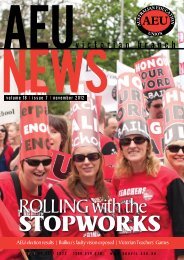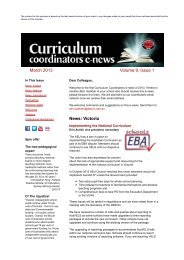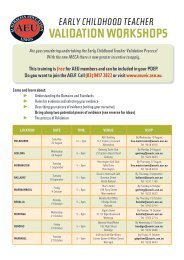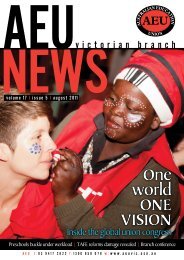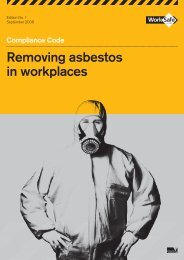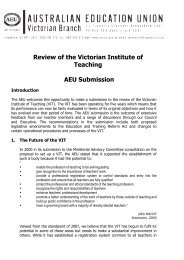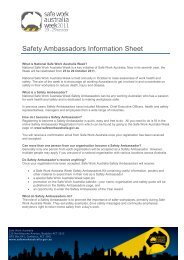Managing asbestos in workplaces - Compliance - WorkSafe Victoria
Managing asbestos in workplaces - Compliance - WorkSafe Victoria
Managing asbestos in workplaces - Compliance - WorkSafe Victoria
Create successful ePaper yourself
Turn your PDF publications into a flip-book with our unique Google optimized e-Paper software.
Appendices<br />
If an employee is required to wear a respirator dur<strong>in</strong>g an <strong>asbestos</strong>-related activity,<br />
the employer needs to issue them with a respirator for their exclusive use. Not only<br />
is this important from a personal hygiene perspective, it also contributes to improved<br />
cooperation by employees to comply with the requirement to wear it and can also<br />
lead to employees tak<strong>in</strong>g better care of it as well.<br />
Individuals must be medically fit to wear a respirator. The employer needs to seek<br />
medical advice if there is any uncerta<strong>in</strong>ty. If a medical condition precludes the use<br />
of negative-pressure respirators, <strong>in</strong>dividuals need to be provided with a cont<strong>in</strong>uousflow,<br />
positive-pressure respirator wherever possible. The suitability of these<br />
<strong>in</strong>dividuals for work <strong>in</strong> the <strong>asbestos</strong> removal <strong>in</strong>dustry needs to be assessed<br />
by a qualified medical practitioner.<br />
Employees with beards or other facial hair (<strong>in</strong>clud<strong>in</strong>g stubble) will not be protected<br />
properly by negative-pressure respirators that require a facial seal so all <strong>asbestos</strong><br />
removal workers us<strong>in</strong>g respirators that require a facial seal must be clean-shaven<br />
otherwise a cont<strong>in</strong>uous flow positive-pressure respirator will be necessary.<br />
Employees need to select a size and make of respirator that fits them. The fit<br />
of a negative-pressure respirator to a persons face is critical. A fit test (a test<br />
that determ<strong>in</strong>es the suitability of a particular respirator for an <strong>in</strong>dividual’s face) <strong>in</strong><br />
accordance with AS/NZS 1715:1994 Selection, use and ma<strong>in</strong>tenance of respiratory<br />
protective devices and the manufacturer’s <strong>in</strong>structions needs to be performed to<br />
assist <strong>in</strong> determ<strong>in</strong><strong>in</strong>g that the respirator fits the <strong>in</strong>dividual. Respirators should never<br />
be worn over the fitted hood of coveralls because the airtight seal on the face may<br />
be affected by the awkward position of the respirator straps.<br />
Respirators must be worn until all contam<strong>in</strong>ated cloth<strong>in</strong>g has been vacuum cleaned<br />
and/or wet-wiped, removed and bagged for disposal, and personal decontam<strong>in</strong>ation<br />
has been completed. Non-disposable respirators need to be cleaned and dis<strong>in</strong>fected<br />
accord<strong>in</strong>g to the manufacturer’s <strong>in</strong>structions and stored <strong>in</strong> a clean, airtight conta<strong>in</strong>er<br />
and out of sunlight when not <strong>in</strong> use.<br />
Don’t forget the use of PPE, <strong>in</strong>clud<strong>in</strong>g respirators, needs to be a last resort<br />
after higher order control measures have been implemented so far as is<br />
reasonably practicable.<br />
Use and ma<strong>in</strong>tenance of respirators<br />
A simple fit check (different to a fit test) <strong>in</strong> accordance with AS/NZS 1715:<br />
1994 Selection, use and ma<strong>in</strong>tenance of respiratory protective devices and the<br />
manufacturer’s <strong>in</strong>structions needs to be performed immediately prior to<br />
commenc<strong>in</strong>g work with the respirator each time it is to be used. This will<br />
determ<strong>in</strong>e whether the respirator can provide an effective seal and protection<br />
should there be airborne <strong>asbestos</strong> fibres <strong>in</strong> the <strong>asbestos</strong>-related activity area.<br />
The respirator must be worn <strong>in</strong> accordance with the manufacturer’s <strong>in</strong>structions<br />
and the coverall hood must go over the respirator straps. At the end of a shift or<br />
at a break, as part of the decontam<strong>in</strong>ation process, ensure that the respirator is<br />
taken off last. Disposable respirators must be disposed of as <strong>asbestos</strong> waste after<br />
a s<strong>in</strong>gle use. Non-disposable respirators must be cleaned and stored <strong>in</strong> a safe place<br />
away from contam<strong>in</strong>ation.<br />
The respirator should never be left ly<strong>in</strong>g around where it can collect dust and should<br />
never be dangled around a person’s neck.<br />
66 <strong>Compliance</strong> code / <strong>Manag<strong>in</strong>g</strong> <strong>asbestos</strong> <strong>in</strong> <strong>workplaces</strong> <strong>WorkSafe</strong> <strong>Victoria</strong>



